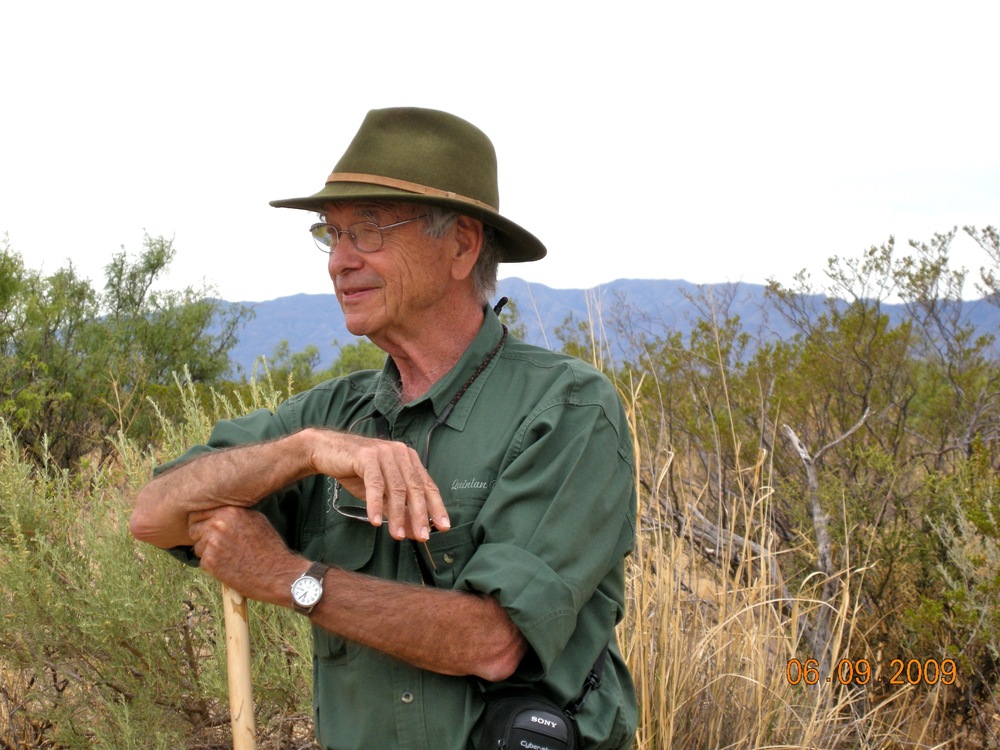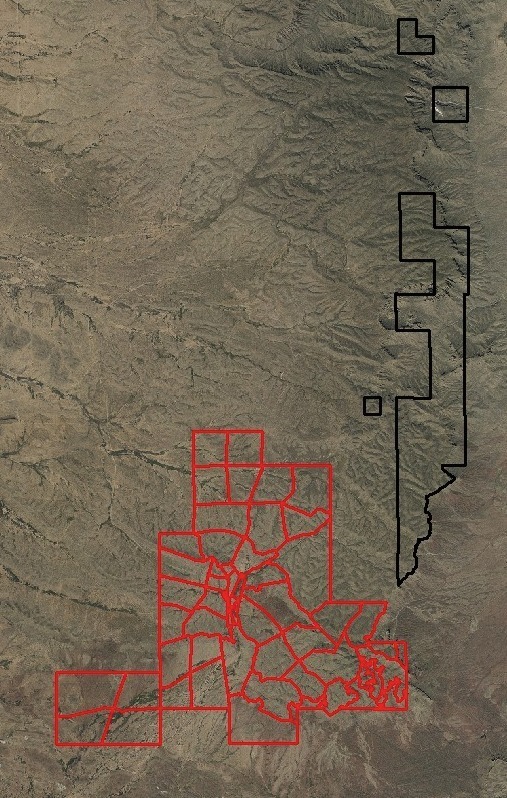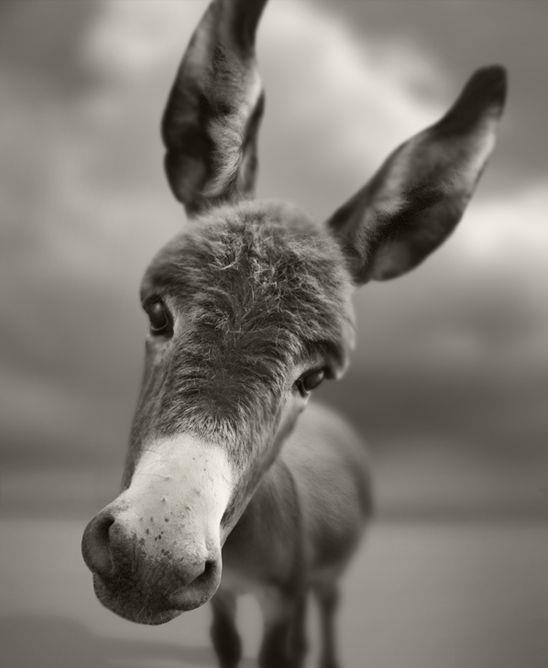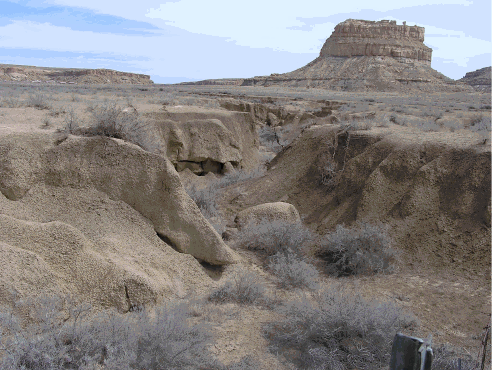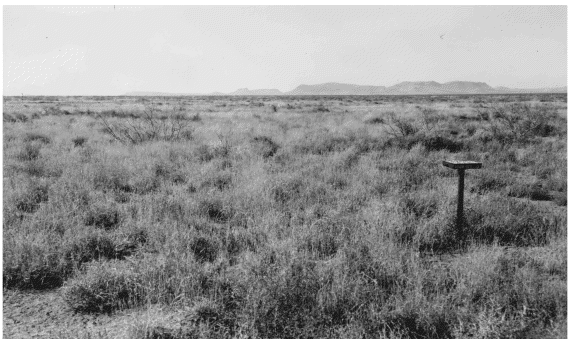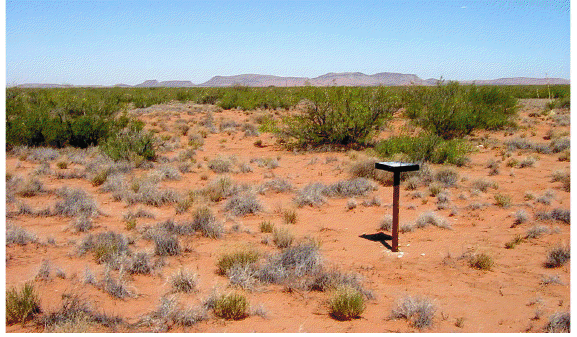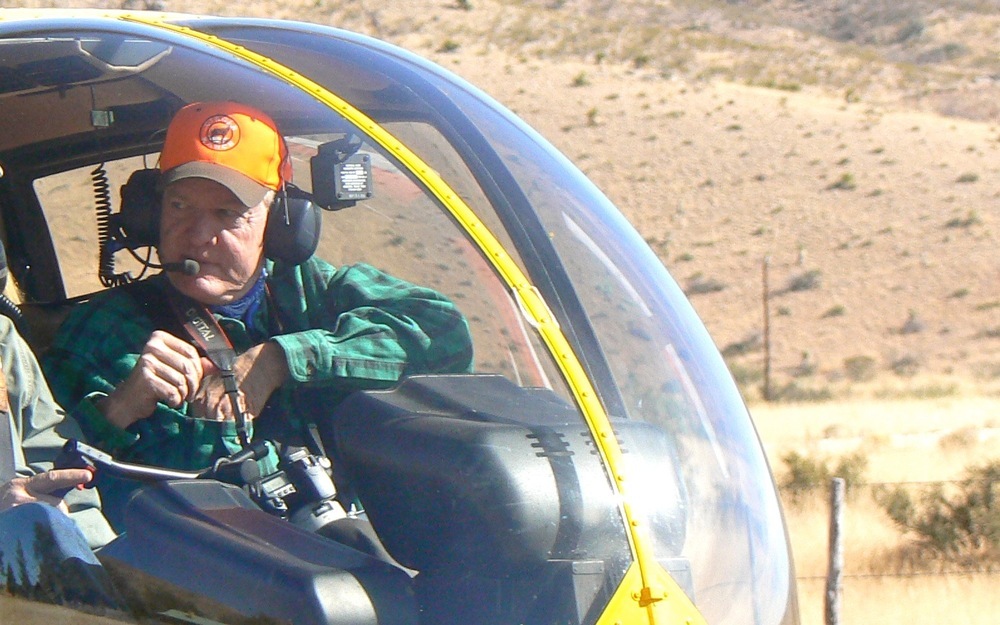Science and Range Scientists
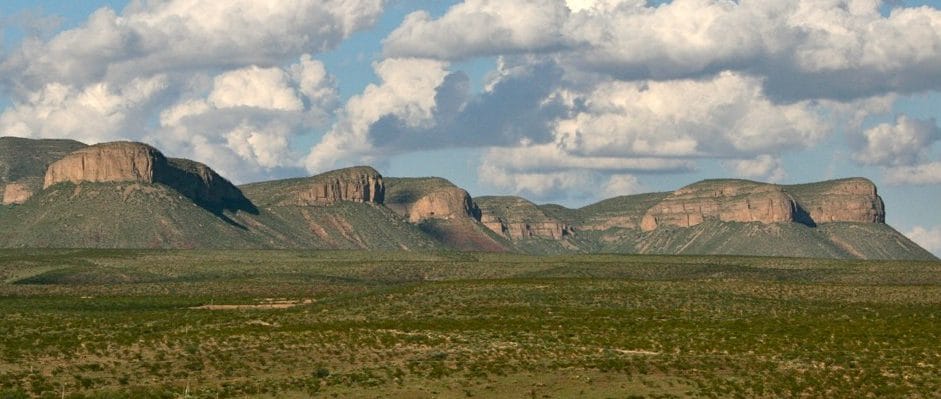
When we bought Circle Ranch in 1999 it had been continuously ranched since about 1881, using domestic livestock like horses, sheep, goats, and cattle. Our intention was not to graze. We had been taught by the range “experts” that if you love your land, you protect it from livestock; if you must run cattle, run as few as possible.
In about 2000 a neighbor invited us down to Cibolo Creek Ranch to meet Allan Savory, a desert-grazing scientist from Africa who founded Holistic Management International (HMI) in Albuquerque. Allan gave a short presentation on how animal impact (grazing, hoof action, dung, urine) can help plants. Allan says gardeners usually understand these concepts quickly. After 40 years of gardening, my wife Laura and I have a practical understanding of the interaction of plants, soil life, water, minerals and sunshine: These insights helped us understand actual range physiology.
In those days HMI was offering a ranch and rangeland management course. Laura and I and two daughters went through it. HMI showed us pragmatic ways to increase ranching profits, taught us grazing planning, and common sense about ranching. The cattle business is a tough place to make money; some areas can be profitable; many are not. HMI has helped us focus on ways that are economically sound, and physiologically adapted to our far-West Texas deserts. These deserts are not well-suited to cow/calf operations which keep herds permanently where it might not rain for years. Animals cannot be present all the time without hurting plants some of the time: over long terms this destroys habitat.

During the last 12 years we have managed Circle Ranch using HMI’s “holistic” grazing principles. We try to mimic nature, not improve on nature. We do not eradicate predators, exotics, or reduce populations of deer by culling does. We have lots of elk, pronghorn, deer, llama, bighorn, and at times we have run as many as 1,000 cattle. Our habitat is slowly and steadily improving.
Immediately below are a series of videos which explain these concepts. The ideas themselves are simple. Their successful application requires attentive management and planning. If you will spend 15 minutes watching these and then apply the principles, you will be more effective than 90% of all professional range and wildlife managers: Their practices rest on the assumptions that (1) land must be protected from large animal numbers, and (2) favorite species can be managed as if they are independent of other species. Both of these assumptions lead to actions which eventually backfire, because they fight nature.
Texas Parks and Wildlife Department’s Faulty Range Science
By 2007 we were seeing good results in terms of wildlife, quail numbers, and stock days of grass available for cattle to graze. Then, in the fall of 2007 I went to a Texas Parks & Wildlife mule deer seminar. There, to my surprise, I was told that the way we graze cattle at Circle Ranch harms plants, water and wildlife. We were given their latest book, Habitat Guidelines for Mule, Deer jointly-published by 23 game departments of Canada and the U.S. Co-authored by Department biologist Clay Brewer, the book refers to many published scientific papers “proving” that planned grazing is a mistake. So I read all the studies on which these conclusions were based. I found that not a single one had studied planned grazing at all. So I wrote this letter to the authors:
A couple of months later, I got the answer below from Dr. James Heffelfinger and his colleagues. Dr. Heffelfinger said that what planned graziers do, is what the book recommends. But then he said the scientific evidence shows that the correct way to run cattle is to have a few cattle around all the time (low-density set-stocking) and never to have large numbers of animals. So I went through it all with him again.
This letter was neither acknowledged nor answered.
>Dr. Heffelfinger also referred to a recently-published study by Dr. Briske at Texas A&M. I had read that and also knew that Dr. Briske was relying on the same studies as Dr. Heffelfinger: the ones that didn’t study planned grazing but something else. So I wrote Dr. Briske the letter immediately below. I said that as far as I could tell, Dr. Briske had not reviewed studies which tested planned grazing, but rather studies that tested something else. I showed Dr. Briske the letters posted above. I referred him to the parts of those letters in which I explained why this is so. I even attached one of the main studies on which he had relied, with my comments to illustrate just what I was talking about.
I asked Dr. Briske why he thought planned graziers had ever recommended the kind of grazing examined in the studies on which he had relied; and why he thought that the grazing principles that we have been so successfully employing at Circle do not work, considering our results.
That was three years ago. Dr. Briske has neither acknowledged nor answered this letter.
Allan Savory at Circle Ranch
Savory really appreciated that I had taken the trouble to analyze the studies relied on by the authors of Habitat Guidelines for Mule Deer. To help me in this discussion he generously returned to Texas from Zimbabwe, where he lives much of the time, in order to gather these authors and 23 state sponsors and personally explain to them what planned grazing really is. We invited every one and even offered to pay for plane tickets. Not one author or sponsor-agency employee attended: that includes any Texas Parks & Wildlife Department staff member of the Sierra Diablo Wildlife Management Area which is located next door.
But several NRCS staff did attend. One, Steve Nelle, wrote the letter posted below to these authors. Steve is not a planned grazier. But he came and looked with honesty. He concluded that while we might not agree on why desert ranges function as they do, what we were doing with domestic animals under planned grazing appeared to have been beneficial to Circle Ranch habitat.
Insofar as I know, this letter was never answered.
Below is the book that I’m talking about. Every wildlife agency in the American and Canadian West signed off on its contents: Alaska, Alberta, Arizona, British Columbia, California, Colorado, Hawaii, Idaho, Kansas, Montana, Nebraska, Nevada, New Mexico, North Dakota, Oklahoma, Oregon, Saskatchewan, South Dakota, Texas, Utah, Washington, Wyoming, and Yukon. All say that the correct way to run cattle in mule deer country is to have a few animals around at all times, or to have no animals at all; and that large numbers of animals are damaging to mule deer ranges.
About a year after this exchange started, I was up in Austin at the Texas Parks and Wildlife Department offices where I ran into the Texas co-author of Habitat Guidelines for Mule Deer, Clay Brewer. I asked Clay about the bad science in his book, and why my letter had not been answered. He said that the on-line version had been corrected. I was thrilled to think I was changing minds within the agencies. Then, I down-loaded and read the “corrected” version. The conclusions and recommendations are identical! Since I had discredited the evidence “disproving” planned grazing, all mention of evidence is omitted. However, the conclusions and bibliography still shows all the same studies: While the new version does not actually say these studies support the conclusions in the book, most folks would think so since they are included in the bibliography. So now, the conclusion that planned grazing harms plants, and water function, is offered without any scientific support. So, I wrote a third letter, discussing this. This letter was neither acknowledged nor answered.
From this exchange I realized that Allan Savory was correct when he told me that regardless of logic, natural history, science or evidence, the bureaucracies would remain “water tight” to these holistic range concepts.
I wrote an article on this futile exchange which was published in Range Magazine.
How Faulty Range Science Leads to Faulty Wildlife Practices
Circle Ranch joins the Sierra Diablo Wildlife Management Area (SDWMA) as shown on the map below.
It seemed logical to me that since Circle Ranch is three times as large as the Sierra Diablo Wildlife Management Area, and since the Department encourages landowners to “cooperate”: work together for the enhancement of habitat and wildlife, that the Department would practice what it preaches and be open to a cooperative effort with Circle Ranch.
The Department does not have a dedicated easement to the Sierra Diablo Wildlife Management Area. The quickest route goes through Circle Ranch. We had offered the Department free access through our ranch for many years, raised money for sheep and Department needs, offered our facilities for Department use, and in general, done everything asked of us and more in order to be cooperative. But we were really worried about the range science being used up at the Sierra Diablo Wildlife Management Area. Because we wanted to learn how we could support the Sierra Diablo Wildlife Management Area, and also have a scientific discussion about better range and wildlife practices, I asked to see the Management Plan for the Sierra Diablo Wildlife Management Area. The Area’s assistant manager told me that no written Management Plan for the Sierra Diablo Wildlife Management Area existed.
When I was in the Texas Parks and Wildlife Department’s Austin offices, the trip when as reported above, I ran into Clay Brewer, I was there for the purpose of meeting Executive Director Carter Smith, to discuss cooperative efforts between Circle Ranch and another property our family owns, next to the Guadalupe Delta Wildlife Management Area. I asked if it was true that no Management Plans existed at the Sierra Diablo Wildlife Management Area. Carter said to make the request in writing and he would find out. I did.
It turned out that there had been a written Management Plan at Sierra Diablo Wildlife Management Area for years. I read it and was shocked to learn that the Department had made it a written policy to eradicate all elk in the Sierra Diablo Mountains. I later learned this policy is also in effect at all of the state-managed WMA’s and Parks in far-West Texas. I have also learned the Department, in exchange for guaranteeing sheep permits and hunting privileges at Sierra Diablo Wildlife Management Area to two of our neighbors, requires that they kill all elk on sight. This is but one of several eradication efforts directed at several species on Department-managed properties and parks in West Texas. Other natives like panther and bison, any exotic, all domestics and some arguably-native animals like wild burros are also targets. The original justification was that all these harm bighorn sheep. But this theory has been discredited by experience. The revised reason is that these animals harm other native wild animals and habitat. Both justifications are wrong. These attacks on biodiversity were undertaken without consultation and in secret. They directly harm our wild animal populations at Circle Ranch. This discovery made me realize I was in direct conflict with Texas Parks and Wildlife Department.
Texas Parks and Wildlife Department’s Faulty Elk Science
Elk have been in Texas for thousands of years. Like deer, pronghorn, turkey, bighorn, bison, wolves, bear and other species, they were virtually wiped out by 1900, since when there have been efforts to reestablish them. Some of this was done by private parties, and much by the Department itself, which for many years released elk and in far-West Texas and regulated elk hunting.
Free-Ranging Bull Elk at Circle Ranch
Contrary to what the Department says, elk were already present in small numbers in the Sierra Diablos at the time that we bought Circle Ranch in 2000: I remember a neighbor telling me that he had bought an elk cow which he put in a one-section, high-fenced enclosure. A day or two after the cow showed up, bull elk were standing outside the fence, looking in at the ladies. The Sierra Diablos are only 20 miles at the closest point from the Guadalupe Mountains; all of that connects up into New Mexico where there have always been elk. Wild elk really range, moving according to where there’s water and feed.
Here is a humorous but factual report of “Earl” an elk whose travels took him thousands of miles across the US.
TPWD staff from Carter Smith down have told me that elk will not move even 20 miles from the Guadalupe Mountains to the Sierra Diablos. They insist that elk, a species which ranged from Canada to Mexico and the Atlantic to the Pacific, were never found in Texas. It’s their story: they are sticking to it.
Like bison, pronghorn, deer, panthers and others, elk move across large areas in our deserts, according to the seasonal range and water conditions. Sierra Diablo elk were always part-time residents and may never have disappeared altogether. We released more elk, and also wild turkey as part of our effort to increase native wildlife.
This collided with the Department’s belief it can run the Sierra Diablo Wildlife Management Area like a sheep factory if it can eliminate all “competitors.” This “single-species” management, which has been discredited in the wildlife literature for decades, is backfiring as habitat declines at the Sierra Diablo Wildlife Management Area prove: this is discussed later.
When I learned that the Department was eradicating elk, I did an initial study on this subject and I sent it to Carter Smith. That letter is attached immediately below.
This is where my confidence in Texas Parks & Wildlife Department really went off the rails.
Since this exchange of letters I have done a far-more extensive study of the issue of whether or not elk are native to Texas. I will provide source data on this at a future date: however suffice it to say that elk indeed are native to Texas, as summarized below.
As shown in the Department website posted below, Texas Parks & Wildlife Department says that (1) elk were never anywhere in Texas except the Guadalupe Mountains: an area that would include perhaps 100,000 acres up on the New Mexico border, and (2) these were an extinct species, Cervus merriami, that disappeared around 1900. Thus all elk living in Texas are non-native, “exotic” animals either because they don’t belong anywhere in Texas outside the Guadalupe Mountains, or because they are the wrong elk species. They also say that (3) all North American elk are of the species Cervus elaphus. Each of these statements is wrong.
I challenge the (1) historic and (2) genetic theories on which Texas Parks and Wildlife has justified its elk killing policy.
Bad History
The historical and archeological evidence shows that elk were native all over Texas, long before being hunted out around 1900. The evidence on this is huge: We found 20 early accounts of elk all around Texas between 1600 and 1900, from Spanish explorers to the great naturalist, John James Audubon and many others. Buried elk bones have been found in Texas by archeologists. Other historic findings of elk in Texas include elk antlers, elk antler hammer tools; elk coprolite (ancient dung); six finds of elk teeth, one associated with the bones; bundles of elk hides; native American cave paintings in the Trans-Pecos; one stone carving of an elk; 10 Texas place names which contain “elk.” Strong elk evidence exists in at least 28 Texas counties and possible evidence in several more. All of this information is available to the public which is how we found it.
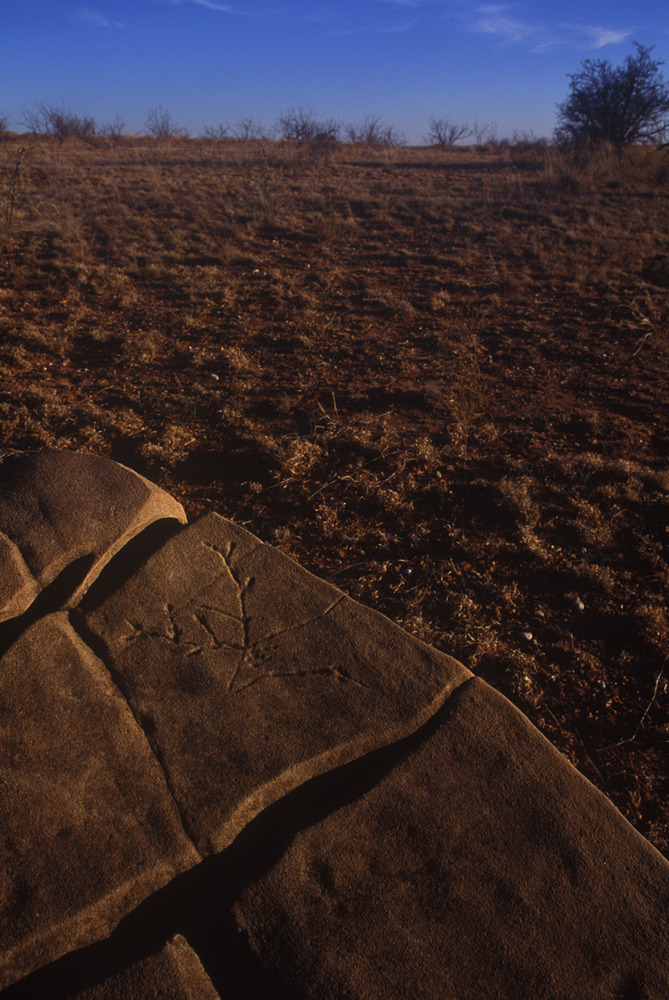
Bad Genetics
There is no genetic evidence that supports the idea that there was ever a Merriam’s elk and there is no clear physical (also called morphological) evidence that might indicate a difference between supposed Merriam’s elk and Rocky Mountain elk. Around 1900, naturalists found fame by discovering “new” species, much as they do today. But the scientific requirements for describing new species were much less rigorous than today. In 1902, Edward Nelson thought that the elk he saw in Arizona were larger than other elk in North America, but elk had been exterminated in Arizona. He therefore studied one Arizona skull in the collection of the American Museum of Natural History in New York and compared it to three other elk skulls from other parts of the country. He also studied one elk skin. He made several measurements of the skull and, in his opinion, the skull measurements of the Arizona skull were larger than the average of the three other skulls. In reality, in only one measurement was the skull larger than all of the other three. The other measurements overlapped. In 1905, Vernon Bailey found part of an elk skull in the Sacramento Mountains of New Mexico, which he decided should be referred to the “new” species described by Nelson. He also spoke to some old-time ranchers in Texas who told him that some years ago elk had been in the Guadalupe Mountains of Texas. He decided that the elk skull found in New Mexico should be referred to the purported species in Arizona and that the extinct elk of Texas should also be assigned to this new species, Merriam’s elk, although no specimen of native elk from Texas was ever examined. In 1978, Anderson and Barlow examined three supposed Merriam’s skulls, compared them to other canadensis skulls, and determined that Merriam’s elk was a marginally valid subspecies, but their data showed that in no dimension were the Merriam’s skulls larger than the other skulls—there was overlap in every dimension—which negates the conclusion that Merriam’s elk was a separate species or subspecies.
Let me quote a few experts on this discussion of elk genetics (also called taxonomy):
- Noted taxonomist and bio-anthropologist, Colin Groves, the author of Ungulate Taxonomy, http://en.wikipedia.org/wiki/Colin_Groves, stated, “There is not—never was—any such thing as “Merriam’s elk” (e-mail to Richardson Gill 2012).
- Speaking of Merriam’s elk as a species, noted wildlife biologist and taxonomist, Valerius Geist, the author of Deer of the World, http://www.themarknews.com/authors/462-valerius-geist, stated, “To consider Merriami’s elk as a different species is complete insanity” (e-mail to Richardson Gill 2012).
- Speaking of Merriam’s as a subspecies, Dale Toweill, senior editor of the encyclopedic, award winning North American Elk: Ecology and Management, http://www.safarinewsreel.com/blog/?p=752, says, “I strongly suspect the designation of C.e. merriami as a distinct subspecies will be overturned …” (e-mail to Richardson Gill 2012). Note: he is speaking of subspecies.
- The Texas Parks and Wildlife Department’s primary range expert in its publication, Habitat Guidelines for Mule Deer, Jim Heffelfinger of the Arizona Game and Fish Department and an adjunct professor at the University of Arizona, http://www.deernut.com/index_files/Page431.htm, David Brown, the now retired Chief of the Game Branch of the Arizona Game and Fish Department and a professor at Arizona State University, and their co-author, Neil Carmony wrote, “The skull measurements of Merriam’s elk fall within the range of normal variation of other elk subspecies. In short, there has not been, and cannot now be, an adequate evaluation and comparison of Arizona’s native elk to other subspecies” (Carmony et al. 2010:73, the italics are mine).
If evidence of this hypothetical Merriam’s elk is so lacking that the animal fails the test as a subspecies, obviously, it also fails as a species. (Note: The foregoing quotes should not be taken to imply that the parties agree with any other comments in this piece.)
The Texas Parks and Wildlife Department also seems unaware that the prevailing taxonomic consensus is that American elk are Cervus canadensis (North American elk), not Cervus elaphus (European red deer)!
So, what animal was native? Texas elk were never a different species or a subspecies from the other Rocky Mountain/Manitoban elk that ranged from the Rocky Mountains to the east into the Great Plains and eastern North America: There were no barriers to the movement and interbreeding of these animals. Genetically they were the same.
Anderson S, Barlow R. 1978. Taxonomic status of Cervus elaphus merriami (Cervidae). Southwestern Naturalist 23:63–70. Available: http://www.jstor.org/pss/3669980 (January 2012).
Carmony NB, Brown DE, Heffelfinger J. 2010. Arizona’s elk restorations. Pages 71–83 in Arizona wildlife trophies 2010. Phoenix: Arizona Game and Fish Department.
Bad Scholarship
Texas Parks & Wildlife relies on their “science” to eradicate one of only four surviving native big game animals in far-West Texas. And yet the Department’s written mission is to conserve native animals, and make all wildlife decisions based on sound science! Government agencies acting contrary to their mission is all-too-common, and not just in Washington. The Department’s internal agenda, sloppy science, and deeply-held beliefs have led it to practices that harm native wildlife and habitat.
A partial explanation of the bad science being used by the Department in elk eradications, with respect to the historic record on Texas elk and the genetic discussion (also called “taxonomic analysis”), is the same. The Department is relying on studies that it has never read. These studies get incorporated as references into ever-growing bodies of the scientific literature, apparently without having anyone go back and check the studies themselves and the studies on which those studies rely. Once something gets repeated, apparently, it is considered proven. You don’t have to be a scientist to know that you couldn’t look at 1 ½ elk skulls and prove a new species. But to understand that is what is happening, you must be diligent enough to actually read those papers that everybody quotes. And if those papers rely on other papers, read those as well. That’s called scholarship.
This lack of scholarship partly explains why the Department is ignorant of the massive accumulation of Texas-elk evidence since Vernon Bailey’s 1905 conclusions, and, why it says that elk and red deer are the same species, a position that, while once accepted, is 20-years out-of-date.
There are other reasons:
- A sympathetic explanation is that, as with its range science, the Department feels no need to reexamine what it believes to have already been proven. These conclusions are applied, not tested. All scientific communities do this. But, as Mark Twain once observed: “It ain’t what you don’t know that gets you into trouble. It’s what you know for sure that just ain’t so.”
- It also reflects internal bureaucratic agendas and collective self-interest. Bureaucracies won’t change positions if changing shows them to have been incompetent. Such error touches pride, personal reputations and potentially harms funding. Your lawyer, accountant, doctor or even car dealer all face professional, legal and financial sanctions if they make representations they know or should have known to be untrue; agencies have no such accountability.
- Lots of funding is available for eradications.
- Killing “undesirable” animals is a tangible goal which can be measured: Habitat improvement is more difficult to demonstrate than body count.
- Some people enjoy flying around in helicopters, killing wildlife with automatic weapons.
The Department has had hundreds of scientifically-degreed employees with thousands of degrees shared between them during this period of elk eradications; billions in federal and state tax dollars have been turned over to this group of scientists in the belief they were acting scientifically. Anyone who can follow this discussion can reach appropriate conclusions about whether those we trusted have lived up to our expectations.
How to Improve the Bighorn Program
Notwithstanding my unsuccessful attempts to get the Department to use better range and wildlife practices, I continue to try and reach out to them to have discussions about how to do this better.
On January 6, 2011 in response to an email communication from Bighorn Manager, Michael Pittman, I sent a letter on desert bighorn releases at Big Bend Ranch and Sierra Diablo Wildlife Management Area. Circle Ranch is a long time financial supporter of desert bighorn reintroductions. Our record for bighorn practices, and our bighorn results are second to none. I made several suggestions on how to improve the Bighorn program.
I tried to reason Mr. Pittman out of wildlife-eradications, this attack on biodiversity, explaining that as these animals are symbiotic, they all do better as part of a mixed animal community, which until recently is how they were found in far-West Texas.
In addition:
- I invited Mike Pittman to come to Circle and see how well elk, bighorn, and mule deer are doing together.
- I reminded Mr. Pittman that in most of the 12 states that have bighorn, they are found alongside elk and mule deer.
- I asked Mr. Pittman to consider that exotic and domestic animals can fill empty biological niches once occupied by wild animals. This can be useful in habitat and wildlife management.
- I asked Mr. Pittman to consider since elk hunts can bring landowners up to $20,000 apiece, elk eradications are costing private owners $millions, and denying Texans the chance to view and hunt free-ranging native elk on state lands managed by the Department for the public.
- I asked Mr. Pittman, what was the cost of aoudad eradications prior to the release of bighorn in the Big Bend Ranch State Park? Also, what did the transplant cost? Also, what was that cost per animal killed, and per animal transplanted?
- I asked Mr. Pittman to consider private landowners should be paying whatever the costs, and would agree to share animals and permits for public hunting. This would make any money go 10-times as far, in my opinion. Transplants would be easier and cheaper using soft trapping and soft releases, from pens built for release and then subsequent re-trapping for transplanting onto other ranches.
- I asked Mr. Pittman to consider since 97% of Texas is in private hands why restrict releases to the 3% that is public?
- I asked Mr. Pittman to consider that shooting aoudad, elk and other wild animals from helicopters with automatic rifles and automatic shotguns is repulsive to ethical hunters, and sets a terrible example for our youth who can only be taught by the examples their elders set.
- I asked Mr. Pittman to consider that we need sound science, responsible handling of public finances, and ethically sound hunting practices.
- I asked Mr. Pittman to help me return the Department to its old positions of supporting elk as a game animal.
Although this letter went to Mr. Pittman, it and all others mentioned in this article have been widely read by Department staff. Our blog at www.circleranchtx.com has been visited by more than 80,000 people. Over 12,000 visits have originated from the Parks & Wildlife servers in Austin. We believe thousands more visits came from their personnel’s, regional and personal computers: Texas Parks & Wildlife is by far our most faithful reader.
This letter was neither acknowledged nor answered.
As discussed, for many years Texas Parks & Wildlife Department has acted on its core beliefs that large animal numbers harm land; that domestics are bad for wildlife and habitat; that species like bighorn can be managed separately, and that favored animals like bighorn will benefit from eliminating large predators and “competing” species. It has operated the Sierra Diablo Wildlife Management Area next door to Circle Ranch employing range and wildlife practices that are dramatically-different than our own. For sixty years, the Sierra Diablo Wildlife Management Area has had no cattle. For decades it has shot or trapped its large predators. It tries to remove all “exotics” including native elk. For several years, the Sierra Diablo Wildlife Management Area has been killing mule deer does and bucks to “protect” stressed habitat based on surveys of some kind, conducted on the Sierra Diablo Wildlife Management Area.
We manage Circle Ranch (w)holistically. We do not attempt to eradicate predators, or eliminate exotics or cull mule deer does. We have lots of elk, pronghorn, deer, bighorn, lamas, and at times, we have run as many as 1,000 cattle. Our habitat, unlike the Sierra Diablo Wildlife Management Area’s, is improving.
Given the Department’s refusal to cooperate with us or even answer our letters, I was surprised in December 2010 to be contacted by Department biologists and asked to allow multi-year browse surveys at Circle. We agreed. In the course of visiting with the biologists during their visits, we learned that the Department expected to confirm that we, like the Sierra Diablo Wildlife Management Area next door, would have over-utilized habitat given our “obvious over-stocking” of our ranges with too many species, and too many animal numbers and especially cattle.
In January 2011 we wrote the Department asking for clarifications and ground rules for the multi-year study of multiple transects at Circle Ranch.
We asked them to acknowledge that doing this was their idea, since they had just refused to enter into a “cooperative agreement” with us, because, (1) we strenuously object to their elk eradications, (2) we will not allow them to aerial gun exotics on Circle Ranch, and (3) we have expressed reservations about financial management of the sheep program. We think that transfer of valuable public permits, and rights to hunt these on the Sierra Diablo Wildlife Management Area, to a favored-few neighbors in exchange for access, and their agreement to kill all elk are not in the public interest.
In the letter posted below, I said that we were prepared to agree to cooperate, whether or not the other requests that we were making were fulfilled. Here those are:
- What does the Department wish to study, and why?
- One of the Department biologists told me that they had complete records and multi-year browse surveys up at the Sierra Diablo Wildlife Management Area: I asked to see them.
- I asked the Department to persuade our neighbors with whom it is working to share their habitat studies. We wish to compare our habitat conditions with theirs, as a means of evaluating whose range practices lead to better outcomes.
- I asked the Department to allow us to study the Sierra Diablo Wildlife Management Area, as it proposed studying Circle Ranch. When we bring in our grazing consultant, Department personnel would be invited to come to Circle and participate in our study. Then, we would look next door at the Sierra Diablo Wildlife Management Area; evaluate how our respective country is responding, as a means of evaluating our different practices.
- I asked that the Sierra Diablo Wildlife Management Area be opened to West Texas field staff. Key personnel with whom we are interacting are not given access to the Sierra Diablo Wildlife Management Area. They advise Circle and other ranches all around the Sierra Diablo Wildlife Management Area on wildlife and habitat practices including doe removals: How can they advise us if they are not aware of what is happening on Department-managed property next door?
An analysis of the Circle Ranch habitat by two teams of Parks & Wildlife biologists confirmed what we knew: No part of Circle has more than moderate usage. This is in contrast to the Sierra Diablo Wildlife Management Area where a browse survey tells its managers that doe removals are necessary.
Doe removals of an animal that is in decline across West Texas seems like a very bad idea. Does on the Sierra Diablo Wildlife Management Area also spend time on Circle, so, the Department is killing our does. Why?
Two and a half months later I got an answer which was not responsive to my questions. So I re-asked those questions. This letter was neither acknowledged nor answered.
After waiting six months for answers I posted the letters to our Circle Ranch blog. This post talked about lack of transparency, lack of good science, and discussed my opinion that the severe cuts being forced on Texas Parks & Wildlife should not fall on Parks or enforcement.
On February 6, 2012, Ruben Cantu wrote me the letter posted below that he had read the blog post and claiming that Parks & Wildlife has in fact been responsive to these letters and requests. Mr. Cantu’s basic point is that he cannot legally share the information requested in my many letters, posted above, as these contain information about private landowners.
While it is true that some questions that I have asked would touch on confidential information, by far most have to do with the Department’s own activities on its own WMA’s.
Furthermore, when the Department does business with private landowners, details of those contracts are not shielded from pubic view. The public is entitled to know who is being guaranteed sheep permits and hunting rights belonging to the public, worth $80,000 each. What is received in exchange? Is this trade in the public interest? All detail of these commercial exchanges are business matters involving public funds.
I disagree that the Department has been responsive to years of questions: My reasons are set forth in the interlined response contained in the letter posted below.
The entire record for doe removals that I have been able to obtain after two years is found on the last page: four entries on two columns! We have recreated the last page, because the records that we have receieved are barely legible.
Here is what Mr. Cantu Sent:
Mr. Cantu also declined to allow us access to the Sierra Diablo Wildlife Management Area to compare its habitat to our own. This refusal violates so many promises contained in the Department’s Wildlife Management Plan of the Sierra Diablo Wildlife Management Area, that I have had to create a separate addendum listing the broken promises, and violations of the Department’s own policies this refusal contains. It is posted here.
According to the Sierra Diablo Wildlife Management Area Management Plan, 75% of its funding comes from Washington. That makes the operation of the Sierra Diablo Wildlife Management Area including wildlife eradications, the business of every American citizen, elected representative, and thousands of federal employees charged with seeing that federal money gets used as agreed.
A related controversy is the burro eradications at Big Bend Ranch State Park. Those who would dismiss the out-of-state signers among the 110,000 petitioners who object to burro and wildlife eradications and the bad science on which these are based, as non-Texans deserving no voice in what goes on Texas public land, would do well to consider the substantial funding of Texas parks by Washington.
For a detailed analysis of this scientifically-unsound and hugely-unpopular action, click here: https://pitchstonewaters.com/burro-trouble
Not one wildlife organization, or the Department’s own oversight body of business and professional leaders have spoken out. This demonstrates that the economic integration of business and government is not restricted to Washington and Big Business. Right here in Texas, Big Wildlife affects so many financial outcomes, for so many individuals and groups, that almost no outsider or insider will disagree with it publicly.
Big Wildlife is a loose coalition of the range, agricultural and wildlife departments of the land grant colleges; plus, federal and state wildlife departments; plus, federal and state park, and land agencies: perhaps 80 in all. On the private side are vendors, including large feed, chemical and equipment manufacturers, consultants, landowners, farmers and game ranchers. Then add dozens of non-profits. All receive government subsidies.
Business, non-profits, academic and government bureaucracies have morphed together at so many levels, as each has sought some economic advantage, usually money or political leverage, from the others. In the process all have lost independence, and the ability to achieve core objectives, be those earning a profit, defense of wildlife, sound science, or some other aspect of the public interest. Many self-serving agendas are at work; habitat and wildlife suffers.
For example: The Rocky Mountain Elk Foundation with 6,000 Texas members will not speak out against eradications of native Texas Rocky Mountain elk, because, as a Texas Director of RMEF put it “We do not want to make things any harder on Texas Parks and Wildlife Department.” Yet, RMEF’s mission is to make things easier for elk, not wildlife bureaucrats!
Big Wildlife is closely-connected to Big Meat and Big Agriculture: These are also heavily-subsidized. Consider what grain subsidies and regulation have done to ranching. Thirty billion dollars are funneled into subsidies to farmers and owners of farmland each year. Seventy percent ($22 billion) goes to the ten largest subsidized farms. Yet this program was started to help small family farmers. Here’s what the Cato Institute says about the problems associated with an entrenched subsidy program:
“The extensive federal welfare system for farm businesses is costly to taxpayers and it creates distortions in the economy. Subsidies induced farmers to overproduce, which pushes down prices and creates political demands for further subsidies.
Subsidies inflate land prices in rural America. And the flow of subsidies from Washington hinders farmers from innovating, cutting costs, diversifying their land use, and taking the actions needed to prosper in a competitive global economy.”
Artificially subsidized feed grains have wrecked the cattle industry. Cheap feed like grain encourages feedlot systems. These tend to conglomerate: 500,000 head of cattle in one feed yard is not unheard of today. Four companies now control 80% of the meat coming out of these feedlots; subsidies notwithstanding, they are going broke and dragging small producers along.
Over-regulation of food processing is even more harmful. Small operators can no longer enter the slaughter and processing business because of rules written to address the utterly filthy conditions of confinement production. These rules (surprise!) favor the large operators, yet, foreign meat is not subject to the same inspections or regulations. Paperwork, tests, and more create insurmountable barriers to small businesses. The decline in small abattoirs is even more precipitous than that of family farms. This guarantees that everyone is locked into the big auction yards, big cattle buyers, Big Meat, Big Food and all the rest.
The perversities of Big Agriculture stand in plain sight. Our ranges no longer have cattle on them: these are in feed lots instead. This is fundamentally damaging to wildlife, because cattle took the place of large grazers like bison, furnishing the animal impact necessary to range health. Millions of cattle in feedlots eating food that humans can digest, animals that are desperately needed on the land to reverse the appalling desertification of the US. An idiot could see that ethanol from corn makes no sense, is inhumane with a billion people going hungry and economically stupid when fossil fuels are cleaner and cost a fraction per btu. Despite this lack of common sense and humanity, thousands of institutional scientists and economists, the best and the brightest, signed off anyway, and also on production of biofuels from crops. Our leaders and the public went along: Big Agriculture like Big Wildlife co-opts common sense. Not surprisingly countless unintended consequences cascade from these actions, consequences that harm wildlife and habitat, our way of life, and endanger the world.
Just one of many bad wildlife consequences is the feral pig “problem”: It is a direct result of wiping out the small abattoirs and making it illegal to put free-range pigs into the food chain. For as long as humans have raised pigs, these animals have been allowed to run free. They have been seasonally gathered and slaughtered. When is the last time that you heard of someone getting sick from wild pork, or any wild game? Yet Big Meat, Big Agriculture, Big Regulators and Big Wildlife say meat from these animals is unwholesome.
What do they offer the public as a wholesome alternative? Why of course animals confined to live on their own feces and urine, fed hormones to stimulate their appetites and accelerate their growth, and prophylactic doses of antibiotics to counteract their filthy living conditions and toxic diets which includes chicken manure. Humans are at risk from those hormones, chemicals, antibiotics and the multiple epidemic diseases caused by the septic conditions of confinement production. If the waste impoundment of a pig farm fails, the result is poisoned rivers with millions of dead fish, contaminated crops and thousands of infected people. We spend millions flying around to aerial gun these animals which are then left to rot, animals which for as long as Europeans have been on this continent have provided a profitable and nutritious source of food. And every year there are more “problem” pigs!
Any day now we will be told that a free-ranging cow is unfit to eat because it was not raised in a feedlot. Then we can have a government program to control feral cattle!
Notwithstanding Big Wildlife’s wish to help wildlife, where the rubber hits the road, wildlife management as practiced has evolved into a broad attempt to impose technological and industrial “cures”, subsidized and directed by government, on animals and their degrading habitat to counteract the damage done by unhealthy range and wildlife practices. High fences, artificial feed, mineral and other supplements, genetic manipulation of wild animals, artificial fertilizers, mechanical manipulation of habitat, single-species management and the other techniques of Big Agriculture are Big Wildlife’s increasingly-preferred methods. In many ways, the worst thing that has ever happened to wildlife is such “wildlife management.”
Agencies are always founded to address a problem. Having done so, they proceed to get involved in areas that are questionable. As they continue to grow, they wind up doing the absurd, and finally are actually harmful to the purposes for which they were begun. So it is that FDA, begun to keep unscrupulous food processors from putting sawdust in bread, offal in meat, and to insure cleanliness, ends up saying that pink slime is beef, chicken manure and chicken parts are a pure cattle food, and feed yards are clean whereas open ranges are dirty. The business community, including farming and ranching interests has been complicit in the process even though it has been fundamentally damaged by the result.
Texas Parks and Wildlife declaring war on elk and on biodiversity, using bad range and wildlife science follows in this pattern. It is what happens when agencies outgrow their core purposes and those who in self defense should be watching them don’t because they themselves are gaming the system.
Counterproductive, wasteful actions starting with all these subsidies were possible in an era of debt-financed excess. This is at an end: Our country is broke. Here is the best, non-partisan article I have read on this economic reality;
(Article © Forbes Magazine December 2011)
The coming long period of severe funding cuts will probably force 50% reductions in the current budget of the Texas Parks and Wildlife Department after taking into account what inflation is going to do to purchasing power. The optimistic view of this mess is that we can make virtue of necessity: Since the easy answer of more debt is no longer available, let’s make some intelligent choices regarding what functions should be protected, and eliminated, in our state agencies. Let us get back to basics.
Texas Parks & Wildlife does two vital things: (1) It maintains parks and public access opportunities for the citizens of Texas, and (2) through law enforcement, it protects wildlife from unscrupulous hunting. These efforts should be as fully-funded as possible, because the public should be given every opportunity to use its parks, and, wildlife’s primary need is game wardens. There is no private-sector alternative to these two core functions.
As hospitality and police functions are incompatible, enforcement should be split into its own department.
That would leave a department charged with (1) Parks and (2) providing these “services” including scientific research, information, and advice. This second category is where the cuts should fall.
Our experience, as reflected in this exchange, shows that the Department is not scientific in its decisions, open about its operations, and does not intend to perform much of what it promises. To the extent it tries, it delivers services of doubtful value and usefulness. The best input we have received on range and wildlife practices have generally come from non-agency sources.
Not only are private sector services better, they are also cheaper. “Free” services is a mirage: Viewed with full allocation of all associated costs being supported by the public, these services cost more, not less, than private sector alternatives. “Free” services undercut the private sector service providers. The result is that the quality of private consultants is harmed, and economic viability of private consultants is endangered. To the extent services are provided to landowners, landowners should pay for them.
This exchange between Circle Ranch and Texas Parks and Wildlife shows again that government is a poor manager of public money. Agencies fight disclosure of what they do, and spend, and any report card not written by themselves. We cannot change how bureaucracies act but in this time of diminished budgets we must choose what to pay for. Even if we could eliminate all waste, public subsidies to private parties, and achieve transparency, we will still face brutal choices between what we might like, and what we can afford.
“This is wilderness area under management by U.S. National Park Service (NPS). It shows the state of the land some 70-years after removal of all livestock, and having had hundreds of thousands of dollars spent on range conservation measures in the meantime! Clearly, NPS, like Texas Parks & Wildlife Department, has no idea what is causing such severe desertification: as bad as anything in Africa.” . . . Allan Savory
Let us also re-examine the fundamentals of our wildlife practices: Unless we change these, why expect different outcomes? For seventy years the range and academic bureaucracies have had their chance to prove that destocking the ranges works, and yet, quail, mule deer, pronghorn and other species are in decline on ranges they have occupied for millions of years. These outcomes speak for themselves. This range science holds that “over-grazing” is responsible for all aspects of range decline including brush incursion; in fact, over-rest is doing most of the damage.
The picture on top is a view of the Jornada Experimental Range in New Mexico not far from Circle Ranch taken in 1961. Below is the same spot in 2002. Livestock have been excluded since the 1950’s by federal range managers. Note the dead grass plants, bare ground and increased brush; these are the classic symptoms of over-rested desert grasslands.
The idea that ranges must be protected from large numbers of animals also leads to these eradication programs which are so damaging to all wildlife and habitat. Texas examples include current burro eradications at Big Bend Ranch State Park, and of native elk, bison, large predators, all “exotics” like aoudad, other wild animals and all domestic animals on public lands managed by TPWD.
Elsewhere, oryx are being eradicated in New Mexico and wild horses across the West. Ranchers are being whittled off the land by BLM stocking rate reductions: This will lead to the eventual destruction of our precious Western ranching culture.
The removals reflect the agencies’ core assumption that animals harm land. As land degrades the medicine (removals) is administered in ever-larger doses, proving the adage, “When your only tool is a hammer, every problem looks like a nail.” In the real world, failure forces change. Not so in government and academia which routinely “double-down” on practices proven to have disastrous consequences. It is not just a Washington phenomenon: It is happening right here on the rangelands of far-West Texas.
We should be restoring bio-diversity using the animals available, and protecting what is left of the wild animal community. To quote Aldo Leopold, “The first precaution of intelligent wildlife tinkering is to preserve every cog and wheel.” Thousands of practitioners of planned grazing across the world are proving on millions of acres that domestic animals and wildlife, when grazed together under attentive management and planning offer the best and only sustainable method of restoring ranges to a condition wherein they can support many wild species including bighorn, mule deer, pronghorn and quail.
Free-Ranging Pronghorn, Elk and Llama on Improving Circle Ranch Habitat During the Great Drought of 2011
I offer two constructive steps to deal with this dilemma, one local, another national:
This coming July 13 & 14, Holistic Management International (HMI) of Albuquerque, NM, in cooperation with the San Antonio and West Texas Chapter of Quail Forever, will present a two-day class Cows and Quail in which we will demonstrate and teach how to use cattle and wildlife to restore plants and habitat for both. It will be useful to every person who wants to reverse wildlife and habitat decline. Cows and Quail combines the wealth of knowledge developed over the last 100 years by wildlife scientists, with the East African grazing techniques discovered by Allan Savory and refined over the last fifty years by planned graziers worldwide, merging these into a combined (holistic) approach to managing animals, plants, soil life, water, minerals and sunlight together, in ways that help the entire system function better. It is a private effort which does not receive monetary or in-kind public support and therefore is free to disagree with accepted range and academic thinking. This two-day class will be based at Van Horn and conducted at Circle Ranch. Tuition is $250.00. Attendees will leave the class with a grazing plan for their ranch that will show them how to address and reverse habitat decline in an affordable, effective, and sustainable manner using the tools of animal impact from wildlife and cattle: tools which pay for themselves. Information on this can be found at: http://holisticmanagement.org/training/cows-quail-workshop/
At a national level, we must call for a Congressional Inquiry into the range practices used across Texas and the West. There is only one range science being taught and used; it originated in the land grant universities. Alaska, Alberta, Arizona, British Columbia, California, Colorado, Hawaii, Idaho, Kansas, Montana, Nebraska, Nevada, New Mexico, North Dakota, Oklahoma, Oregon, Saskatchewan, South Dakota, Texas, Utah, Washington, Wyoming, and Yukon use it as do the BLM, Forest Service, NRCS, BIA, TPWD, etc.: i.e. everyone, everywhere. At this hearing the authorities should not be allowed to control the evidence and testimony given on these practices. These agencies sincerely consider themselves the Voice of Authority, and dismiss those of us who challenge them as uninformed and emotional. There can be nothing more important for ourselves and our communities than such a fundamental review.
About The Author
https://pitchstonewaters.com/christopher-gill-bio
Please let me introduce myself. I am a pragmatic businessman and rancher with no agenda other than protecting private property rights, promoting ethical hunting, and the conservation and restoration of wild animals and their habitat. Conservation and ecological ethics demand each of us should speak up for the wild animals that cannot speak for themselves; and against practices however popular, that harm the land.
“One of the penalties of an ecological education is that one lives alone in a world of wounds. Much of the damage inflicted on land is quite invisible to laymen. An ecologist must either harden his shell and make believe that the consequences of science are none of his business, or he must be the doctor who sees the marks of death in a community that believes itself well and does not want to be told otherwise.”
― Aldo Leopold, A Sand County Almanac

